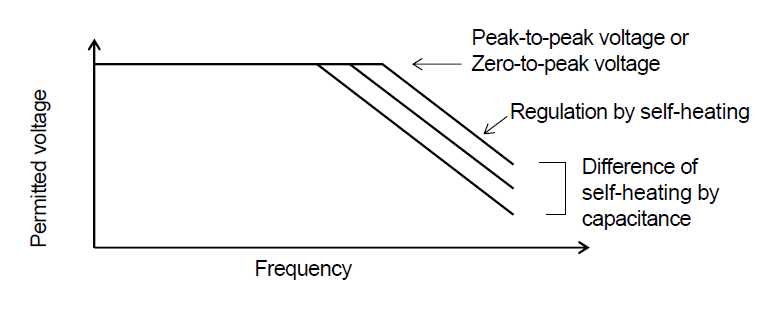Applied voltage and self-heating temperature
Confirm whether AC voltage and pulse voltage are continuously applied to the capacitor.
Be sure to take into account self-heating when using DC capacitors for AC or pulse circuits.
General capacitors are designed for DC use. When they are used in a circuit where AC or pulse voltage is applied, the current value may increase and the capacitors may short-circuited due to self-heating.
- (1)For capacitors of Class 2, it is necessary to maintain the surface temperature shall not increase more than 20°C.
- (2) For capacitors of Class 1, since the permitted temperature rise depends on the dielectric
material, consult us about the details.
Note: Class 1 : Temperature compensating capacitor (C0G, NPO)
Class 2 : High dielectric constant capacitor (X5R, X7R)
When pulse voltage with very short rising time or AC voltage with a high frequency is applied to a capacitors, even within the rated voltage the reliability of the capacitor may be influenced.
When pulse voltage or AC voltage is applied to capacitors, even within the rated voltage,
the capacitor may generate heat due to the current.
This self-heating is mainly generated in the dielectric by its dissipation or at the junction between
electrodes and dielectric. The self-heating or the current induced by the heat causes the deterioration of
insulation and/or damage to the electrodes.
If a current which causes self-heating is below the specified value, the capacitor deteriorates very
little. However, if a large current causes a high temperature exceeding the specified value, the
deterioration of the capacitor may be accelerated and cause a burnout.
Self-heating of a capacitor depends on the dielectric material, the capacitance, the applied voltage, the
frequency, the voltage waveforms and others factors.
Moreover, the surface temperature may be affected by heat radiation related to the style of the
capacitor, the mounting method to the equipment and the ambient temperature.
Since self-heating affects the characteristics of capacitors when ambient temperature changes, even under
the same voltage conditions, perform the confirmation of self-heating at room temperature (25 °C).
Generally, the correlation of the frequency and voltage, which can be applied to the capacitor, is
restricted by peak-to-peak voltage in the low frequency bands, and is restricted by self-heating in the high
frequency bands.
(See the following figure)
Since circuits used in the field have various kinds of voltage waveforms, it is difficult to prepare
such data considering all conditions. Consult the component manufacturers or confirm actual self-heating in
the equipment.

Safety Application Guide for Multilayer Ceramic Chip Capacitors All Lists






